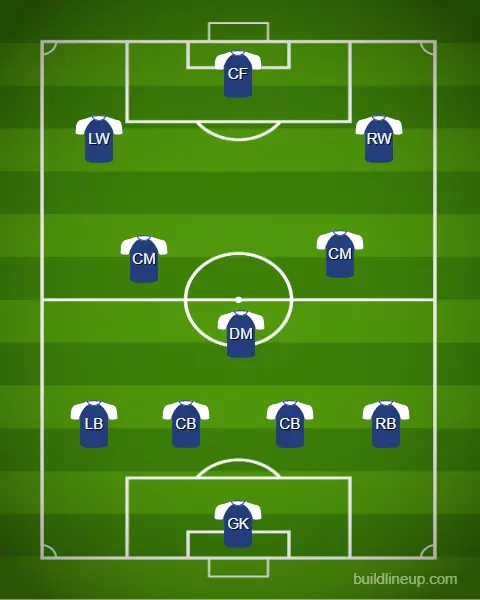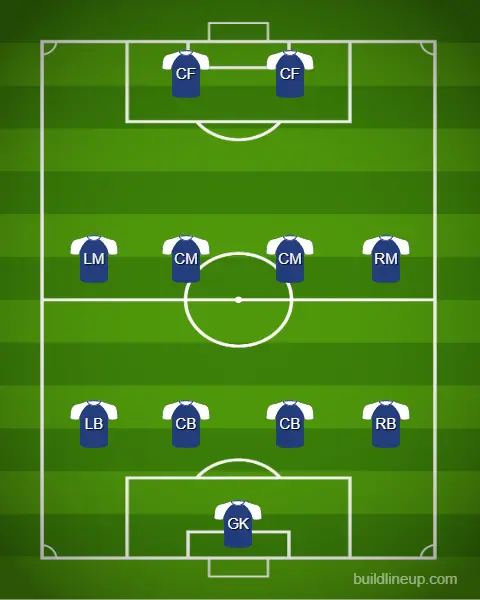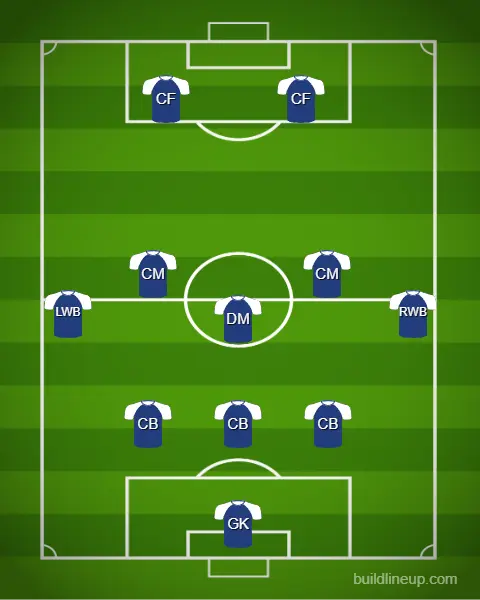In soccer, tactical formations are integral in deciding what position every player in the team would occupy on the pitch. The formational shapes ultimately dictate the flow of the game and determine in what way or style a team would play their game. At the same time, utilising the best way possible according to the players and resources in the squad.
The types of tactical shape and formational strategy usually depend on the coaching style of the Manager and the head coach’s preferences. Since they assign their players specific positions within the formation to make the most of their capability. In this article, we will be discussing the most popular soccer and widely implemented formations which are being used by top clubs and teams around the world:
1) 4-3-3
The 4-3-3 is the most popular and widely used tactical soccer formation in modern times – used by some of the biggest teams in the world. The origin of the 4-3-3 setup dates back to the 1958 World Cup when Brazil started using a four-man back line in a 4-2-4 formation and subsequently evolved into three players in midfield with one player dropping in the middle. Thus, giving birth to the most famous formation.
In this set-up, teams play four defenders, and two centre-back pairs alongside full-backs on either side. In the middle three midfielders – the central midfielder’s role depends on the team’s mentality. Whether they play a holding role or operate side by side with fellow two midfielders. Upfront, two attacking wingers on wide channels to run down the flanks and a centre-forward complete the trio.
Zinedine Zidane’s Real Madrid team during 2016-2018 heavily used the style and managed to assemble the most lethal attacking team in Europe that won the UEFA Champions League triumph thrice in a row. Similarly, Liverpool’s former manager Jurgen Klopp had regularly used the 4-3-3 attacking formation during his tenure at Anfield and had huge success.

Advantages
-It provides an ideal balance to the team between the attack and defence – avoiding the overload in the attack or high defensive back line.
-It can be used to press the opposition with high intensity, help in retrieving the ball possession in advanced areas and quickly transition into a counter-attack.
Disadvantages
-When out of possession, opposition attackers may get the chance to exploit the spaces left behind while pushing forward.
-In order to excel in the 4-3-3 formation, players required high intensity and stamina to track back and make quick attacks.
2) 4-4-2
The classic 4-4-2 system is also among the most commonly used formations nowadays. It was pioneered by the famous Soviet and Russian coach Viktor Maslov, who introduced a variation to the 4-2-4 formation by using four midfielders instead of two. Subsequently, the formation was widely embraced by English teams to such an extent, that it has now been considered as an English system. Premier League clubs have relied heavily on this tactic in the past two decades.
This formation comprises —- two banks of four defenders and midfielders supporting two strikers upfront. When in possession the two wide midfielders can drift forward to act as wingers and support the strikers. The two midfield and defensive blocks prevent the opposition from easily penetrating with compact structures. However, in recent times this traditional formation has been out of fashion with only a few major teams using it such as Diego Simone’s Atletico Madrid effectively implants this tactic in the modern game.

Advantages
-This system provides defensive compatibility with a four-man midfield ahead of the backline supporting improving the overall stability.
-Wide midfielders and fullbacks overlapping runs on flanks help create pressure by spamming crosses and opportunities for the strikers.
Disadvantages
-The two central midfielders, often find themselves outnumbered by opponents midfield, as wide midfielders isolated on flanks.
-It is physically demanding and requires players to press high and tack back to defend following losing possession.
3) 4-2-3-1
The most popular formation in soccer, right now — in the last decade it has been popularised among Premier League and La Liga clubs. In the early 2000s, the trend of playing two defensive midfielders instead began adapting to prevent the liberty to access the space in between the lines by opponents.
In this setup, four defenders in the back line are protected by two defensive midfielders sitting in between the three-man midfield and defence known as a double pivot. Additionally, three attacking midfielders one as number 10 and two wide midfielders on either side. Upfront alone number nine striker completes the formation.
Modern tactical masters like Pep Guardiola for Manchester City, Mauricio Pochettinho for Tottenham Hotspurs, and Hansi Flick at Bayern Munich are the names who prefer this formation regularly. It’s one of the most popular soccer formations. Most recently in the European Championship (Euro) 2024, Spain coach Luis de la Fuente led them to clinch the trophy — displaying a dominant and free-flowing gameplay using 4-2-3-1 utilising most of his players and creating an undefeated side in the tournament.

Advantages
-It is best suited to build up play from the back and keeping possessions to stretch the opponent’s formation.
-Two defensive midfielders as Double pivots provide stability to defence, making it more difficult to find space between the lines.
Disadvantages
-The three attacking midfielders need to be flowing and high work rate nature to move across the midfield combined with full-backs and also get into half-spaces.
-When out of possession — the loan striker upfront can become isolated making it challenging for them as a result they are required to drop deep.
5) 4-1-2-1-2
The 4-1-2–1-2 is also known as the diamond formation due to its midfield shape. It is derived from a variation of 4-3-3, with one of the attackers from the front three dropping into midfield to take up the number 10 role or central attacking midfielder, alongside two wide midfielders and a defensive midfielder. In a diamond setup, the back line comprises four defenders, one central defensive midfielder ahead protecting the defence, two midfielders wide as Left and right midfielders covering the wide channels.
An attacking midfielder who creates chances for the team — acting as a linkup between the midfield and attack by often dropping, moving in advance positions occupying half space and at times drifting into the 18-yard box. And a combo of two centre forwards in the attack.
Recently, Real Madrid manager Carlo Ancelotti made use of 4-1-2-1-2 prominently playing Jude Bellingham as number ten and Vinicius jr and Rodrygo as two strikers and managed to bring immense success to club last 2023-24 season. In past, Juventus under Maximilliano Allegri and Graham Potter at Brighton were regularly using this formation.

Advantages
-In the midfield, the four-man midfielder creating a diamond structure helps to dominate the middle overpowering the opposition’s midfield unit — with the full-back also getting onto advanced spaces.
-The attacking midfielders provide width dragging the rival’s defence to open up spaces for midfielders and forwards in central areas.
Disadvantages
-The players must be versatile and dynamic to adapt to this formation especially — midfielders and forwards which means regularly tracking back.
-Off-the-ball movements by two centre-forwards and a four-man midfield become crucial for restricting the opposition’s movement in possession.
6) 3-5-2
The 3-5-2 formation was invented by Carlos Bilardo — the famous Argentine coach who led Argentina to a 1986 World Cup triumph having Diego Maradona as key player in his team, who was given a free role with more space on the field. In this tactical shape, three defenders are used behind a five-man midfield setup with three midfielders, two wingbacks (fullbacks in an advanced role) and two forwards playing upfront.
In modern times, prominent managers such as Antonio Conte during his spell at Chelsea and Juventus excelled in this system. This setup has been a go-to system for Simone Inzaghi managed Inter Milan which helped them to win the Serie A title last season. While Jose Mourinho and Diego Simone also often use the formation.

Advantages
-The three-man centre-back helps in building up from the back during possession, with wing-back playing versatile roles.
-The wing’s backs dopping in defence makes the defence line more compact with five-man at back closing down the width.
Disadvantages
-The nature of wing-backs going forward might leave space behind for the opposition to exploit.
-The players are required to be very disciplined from midfielders, and centre-backs to wing-backs in their roles to maintain the shape of the formation.
7) 3-4-3
Another popular formation on the list is 3-4-3 is said to have been first used in the early 20th century and believed that it was being used in Italy where three men at defence was a common phenomenon. Legendary player turned manager Johan Cruyff used to convert his Barcelona 4-3-3 setup into 3-4-3 when one of the defenders advances into the midfield. Teams who rely on inverted full-backs often find themselves in 3-4-3 when playing an attacking 4-3-3 shape while having possession.
In this set-up, three defenders are used at back, four-man midfield including two central midfielders and wing backs on wide flanks. Three attacking forwards ahead. This formation was regularly used by Thomas Tuchel during his time at Chelsea using his wing-backs to stretch the game wide on the flanks and running down the channels. Another Chelsea boss, Antonio Conte also made use of 3-4-3 during his reign at Stamford Bridge. Whereas, Mauricio Pochettinho had been lining up his eleven at Tottenham Hotspurs and Southampton in this tactical shape.

Advantages
– The 3-4-3 formation forms a perfect balance between attack and defence. It provides enough bodies to attack with five outfield players including the wing backs can combine with two forwards creating chances across half spaces.
– The double pivot in front of three centre-backs provides more stability to the defence in dealing with quick counterattacks and block spaces in central areas preventing the opponent’s penetration between the lines.
Disadvantages
– The constant movements of full-back and wings on wide areas could create ample spaces when out of position during possession-lost, thus they could become a vulnerable area in the lineup.
– The players require a high work rate and intensity especially the full-backs and midfielders, who would be tasked with running up and down throughout the entire 90 minutes.
FAQs-
Q. What is the best formation in soccer?
4-3-3 is the most widely used and best soccer formation currently.
Q. What is the 4-2-1-3 formation?
The 4-2-1-3 has 4-defenders, 2-defensive midfielders, an attacking midfielder and 3-forwards.
Q. Which club uses the 3-5-2 soccer formation?
Italian club Inter Milan uses the 3-5-2 formation the most.
